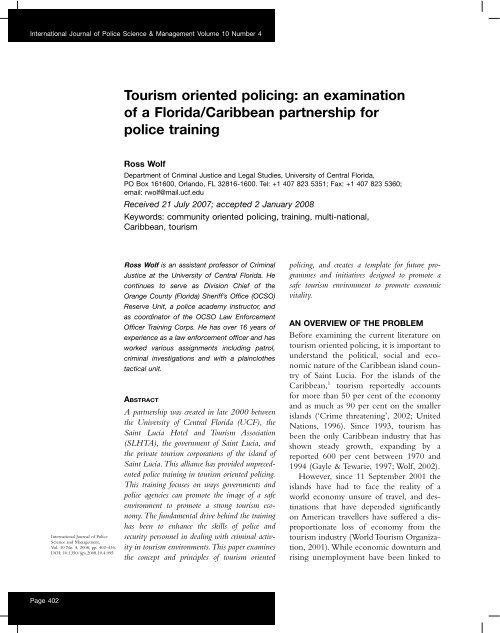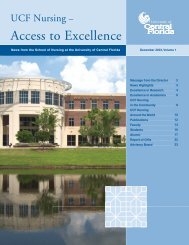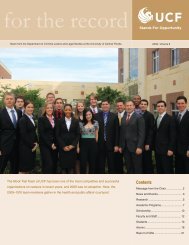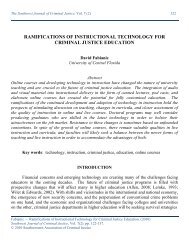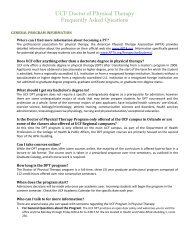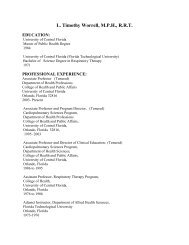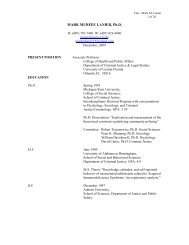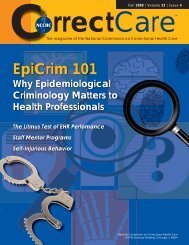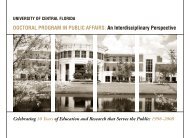Tourism Oriented Policing - University of Central Florida
Tourism Oriented Policing - University of Central Florida
Tourism Oriented Policing - University of Central Florida
Create successful ePaper yourself
Turn your PDF publications into a flip-book with our unique Google optimized e-Paper software.
International Journal <strong>of</strong> Police Science & Management Volume 10 Number 4<br />
Page 402<br />
International Journal <strong>of</strong> Police<br />
Science and Management,<br />
Vol. 10 No. 4, 2008, pp. 402–416.<br />
DOI: 10.1350/ijps.2008.10.4.095<br />
<strong>Tourism</strong> oriented policing: an examination<br />
<strong>of</strong> a <strong>Florida</strong>/Caribbean partnership for<br />
police training<br />
Ross Wolf<br />
Department <strong>of</strong> Criminal Justice and Legal Studies, <strong>University</strong> <strong>of</strong> <strong>Central</strong> <strong>Florida</strong>,<br />
PO Box 161600, Orlando, FL 32816-1600. Tel: +1 407 823 5351; Fax: +1 407 823 5360;<br />
email: rwolf@mail.ucf.edu<br />
Received 21 July 2007; accepted 2 January 2008<br />
Keywords: community oriented policing, training, multi-national,<br />
Caribbean, tourism<br />
Ross Wolf is an assistant pr<strong>of</strong>essor <strong>of</strong> Criminal<br />
Justice at the <strong>University</strong> <strong>of</strong> <strong>Central</strong> <strong>Florida</strong>. He<br />
continues to serve as Division Chief <strong>of</strong> the<br />
Orange County (<strong>Florida</strong>) Sheriff’s Office (OCSO)<br />
Reserve Unit, a police academy instructor, and<br />
as coordinator <strong>of</strong> the OCSO Law Enforcement<br />
Officer Training Corps. He has over 16 years <strong>of</strong><br />
experience as a law enforcement <strong>of</strong>ficer and has<br />
worked various assignments including patrol,<br />
criminal investigations and with a plainclothes<br />
tactical unit.<br />
ABSTRACT<br />
A partnership was created in late 2000 between<br />
the <strong>University</strong> <strong>of</strong> <strong>Central</strong> <strong>Florida</strong> (UCF), the<br />
Saint Lucia Hotel and <strong>Tourism</strong> Association<br />
(SLHTA), the government <strong>of</strong> Saint Lucia, and<br />
the private tourism corporations <strong>of</strong> the island <strong>of</strong><br />
Saint Lucia. This alliance has provided unprecedented<br />
police training in tourism oriented policing.<br />
This training focuses on ways governments and<br />
police agencies can promote the image <strong>of</strong> a safe<br />
environment to promote a strong tourism economy.<br />
The fundamental drive behind the training<br />
has been to enhance the skills <strong>of</strong> police and<br />
security personnel in dealing with criminal activity<br />
in tourism environments. This paper examines<br />
the concept and principles <strong>of</strong> tourism oriented<br />
policing, and creates a template for future programmes<br />
and initiatives designed to promote a<br />
safe tourism environment to promote economic<br />
vitality.<br />
AN OVERVIEW OF THE PROBLEM<br />
Before examining the current literature on<br />
tourism oriented policing, it is important to<br />
understand the political, social and economic<br />
nature <strong>of</strong> the Caribbean island country<br />
<strong>of</strong> Saint Lucia. For the islands <strong>of</strong> the<br />
Caribbean, 1 tourism reportedly accounts<br />
for more than 50 per cent <strong>of</strong> the economy<br />
and as much as 90 per cent on the smaller<br />
islands (‘Crime threatening’, 2002; United<br />
Nations, 1996). Since 1993, tourism has<br />
been the only Caribbean industry that has<br />
shown steady growth, expanding by a<br />
reported 600 per cent between 1970 and<br />
1994 (Gayle & Tewarie, 1997; Wolf, 2002).<br />
However, since 11 September 2001 the<br />
islands have had to face the reality <strong>of</strong> a<br />
world economy unsure <strong>of</strong> travel, and destinations<br />
that have depended significantly<br />
on American travellers have suffered a disproportionate<br />
loss <strong>of</strong> economy from the<br />
tourism industry (World <strong>Tourism</strong> Organization,<br />
2001). While economic downturn and<br />
rising unemployment have been linked to
crime causally, tourists can easily be discouraged<br />
from visiting places that raise concern<br />
for their safety (Pizam, Tarlow, &<br />
Bloom, 1997). This pattern is cyclical<br />
because the fewer visitors a town or community<br />
receives, the less viable the local<br />
economy (‘Crime threatening’, 2002; Sonmez,<br />
Apostolopoulos, & Tarlow, 1999).<br />
These factors in turn are, and have been<br />
referred to in the literature as, key indicators<br />
<strong>of</strong> increasingly criminogenic communities.<br />
Even with increased marketing<br />
efforts, it is difficult to change public opinion<br />
in the aggregate; much less in specific<br />
locales when critical incidents take place.<br />
One does not have to look very far to<br />
understand this effect. Following the disappearance<br />
<strong>of</strong> Natalee Holloway, tourism in<br />
Aruba has reportedly declined as much 6<br />
per cent in 2006, creating an economic<br />
depression there as a reaction to the disappearance<br />
and subsequent boycott <strong>of</strong> the<br />
travel to the island (Taub, 2006).<br />
Despite random and organised crime, the<br />
islands <strong>of</strong> the Caribbean have struggled to<br />
maintain an attractive posture for tourism,<br />
knowing that serious or violent crime can<br />
greatly inhibit any state effort to attract<br />
more visitors to a given region (Smith,<br />
2004). Jamaica is an example <strong>of</strong> one such<br />
tourist destination that has fallen victim to<br />
this negative perception; the net crime rates<br />
have had a domino effect on that country’s<br />
tourism economy (de Albuquerque &<br />
McElroy, 1999; Harriott, 2000). Through<br />
ventures with the Caribbean Regional Programme<br />
for Economic Competitiveness<br />
(CPEC), Jamaica is attempting to fight this<br />
perception, gaining only limited success.<br />
Despite the fact that most other island<br />
nations do not have the same scale <strong>of</strong> problems<br />
as that <strong>of</strong> Jamaica, crime on one island<br />
is <strong>of</strong>ten linked to the entire Caribbean,<br />
‘which in turn discourages tourists from<br />
visiting not only the country in question,<br />
but the whole region’ (‘Crime threatening’,<br />
2002; see also Pizam et al., 1997). Further<br />
complicating the matter is that many European<br />
and American governments regularly<br />
issue alerts and advisories which warn<br />
against travel to certain countries and<br />
regions, including Caribbean nations.<br />
While Saint Lucia has very little crime to<br />
speak <strong>of</strong>, the leaders <strong>of</strong> the nation are very<br />
concerned with its reputation. Further,<br />
while they do not foresee the same or even<br />
similar events occurring in their country<br />
as those that have befallen others such as<br />
Jamaica and Aruba, they do understand the<br />
likely impact on their nation’s economy if<br />
they do not plan ahead, and take measures<br />
to insure the protection <strong>of</strong> those that vacation<br />
within their jurisdictional boundaries<br />
(de Albuquerque & McElroy, 1999).<br />
There is no doubt that ‘fear <strong>of</strong> crime’, or<br />
the fear <strong>of</strong> becoming a victim <strong>of</strong> a crime,<br />
may cause people to restrict their behaviour<br />
to ‘safe places or safe times or avoid certain<br />
activities they perceive to be dangerous’<br />
(Pantazis, 2000, p. 432). While conventional<br />
wisdom holds that those most fearful <strong>of</strong><br />
crime would be past victims, this is not<br />
always the case. Meadows (2001) discusses<br />
the ‘fear-victimization paradox’ where those<br />
who have never been victims <strong>of</strong> crime, or<br />
have never really been exposed to crime,<br />
are <strong>of</strong>ten the most fearful. This paradox is<br />
especially important for tourism planners<br />
and those countries that depend on tourism<br />
for their nation’s economic vitality. It is<br />
<strong>of</strong>ten the affluent who travel overseas, or<br />
to exotic locations, who typically are<br />
untouched by crime at home. Thus it stands<br />
to reason that if potential tourists perceive a<br />
region to be dangerous, their fear <strong>of</strong> crime<br />
may prevent them from travelling far from<br />
home or limit their travel to those locations<br />
deemed as safe (Meadows).<br />
While fear <strong>of</strong> crime is not a new concept,<br />
or new to the travel industry, it is a<br />
recent development for an entire nation or<br />
a given region to focus efforts on improving<br />
their reputation <strong>of</strong> being a safe and stable<br />
environment. ‘This desire is economically<br />
Wolf<br />
Page 403
<strong>Tourism</strong> oriented policing<br />
Page 404<br />
driven, as market research has shown that a<br />
high percentage <strong>of</strong> travelers factor hotel<br />
safety and security in to their choice <strong>of</strong><br />
lodging and that they would be more likely<br />
to stay in a hotel that is safety and security<br />
certified’ (de Treville & Longmore-<br />
Etheridge, 2004, p. 62): the same can be<br />
true <strong>of</strong> a region a traveller chooses for a<br />
vacation destination.<br />
PROBLEM STATEMENT<br />
The Royal Saint Lucian Police Force<br />
(RSLPF) and the Saint Lucia Hotel and<br />
<strong>Tourism</strong> Association (SLHTA) approached<br />
the <strong>University</strong> <strong>of</strong> <strong>Central</strong> <strong>Florida</strong> (UCF) to:<br />
1. develop a relationship between police<br />
training, the tourism industry and tourists<br />
that would successfully implement a<br />
new and innovative ‘<strong>Tourism</strong> <strong>Oriented</strong><br />
<strong>Policing</strong> Model’ in Saint Lucia;<br />
2. encourage the police to protect and be<br />
conscious <strong>of</strong> the tourism community on<br />
the island; and<br />
3. develop an understanding <strong>of</strong> the need<br />
for citizens to feel equally protected<br />
from crime as the foreign travellers.<br />
LITERATURE REVIEW<br />
This paper examines the partnership created<br />
in late 2000 between the <strong>University</strong> <strong>of</strong><br />
<strong>Central</strong> <strong>Florida</strong>, the Saint Lucia Hotel and<br />
<strong>Tourism</strong> Association, the Government <strong>of</strong><br />
Saint Lucia and the private tourism corporations<br />
<strong>of</strong> the island <strong>of</strong> Saint Lucia to<br />
provide tourism oriented policing training<br />
for the Royal Saint Lucia Police Force. The<br />
literature on tourism policing is not as<br />
robust as other areas <strong>of</strong> policing, and is<br />
largely found in journals and texts related to<br />
the hospitality industry. Despite the fact that<br />
this literature is rather obscure to many<br />
traditional criminologists and criminal justice<br />
academicians, there is a significant<br />
amount <strong>of</strong> published material in mainstream<br />
journals that deserves attention.<br />
Types <strong>of</strong> tourism related crime<br />
The literature reveals four categories <strong>of</strong><br />
crimes involving tourists: (1) <strong>of</strong>fences committed<br />
by tourists; (2) <strong>of</strong>fences directed<br />
against tourists; (3) <strong>of</strong>fences that are criminal<br />
services for tourists; and (4) criminal<br />
<strong>of</strong>fences that relate to the tourist economy<br />
<strong>of</strong> an area (Prideaux, 1996). Similarly,<br />
Glensor and Peak (2004) state that tourist<br />
crimes generally involve one <strong>of</strong> four different<br />
scenarios: (1) the tourist as accidental<br />
victim; (2) the tourist is in a location conducive<br />
to crime; (3) tourists are more prone<br />
to taking risks while on vacation, increasing<br />
the chances they will become victims; and<br />
(4) terrorist and other groups may target<br />
tourists (see also: Chesney-Lind & Lind,<br />
1986; Cohen, 1987; de Albuquerque &<br />
McElroy, 1999; and Holcomb, 2004). This<br />
article focuses specifically on crime against<br />
tourists because these are the <strong>of</strong>fences that<br />
are most likely to have a negative impact on<br />
the local economy <strong>of</strong> an island nation such<br />
as St Lucia.<br />
The focus <strong>of</strong> the problem in Saint<br />
Lucia<br />
A problematic social and political factor<br />
regarding the implementation <strong>of</strong> a tourism<br />
oriented policing model in Saint Lucia was<br />
the need for the citizens to feel equally<br />
protected from crime as the tourists.<br />
Although the crime rate in Saint Lucia is<br />
relatively low in comparison with neighbouring<br />
Caribbean islands (de Albuquerque<br />
& McElroy, 1999), two theories <strong>of</strong> crime<br />
control are most <strong>of</strong>ten used to understand<br />
the criminal activity in tourism environments<br />
and can also be used in Saint Lucia:<br />
‘routine activity theory’, and its <strong>of</strong>fshoot<br />
‘hot spot theory’. Routine activity theory<br />
(Cohen & Felson, 1979; see also Boetig,<br />
2006) assumes three basic elements: a suitable<br />
victim or target, a motivated <strong>of</strong>fender,<br />
and the absence, or perceived absence, <strong>of</strong><br />
capable guardians. In this context, capable
guardians may be the police, security guards<br />
or even housekeepers who are wary <strong>of</strong> their<br />
surroundings. Hot spot theory (Sherman,<br />
Gartin, & Buerger, 1989; Sherman et al.,<br />
1998) builds on routine activity theory and<br />
assumes that victims converge on locations<br />
where crimes are more likely to occur, and<br />
that the addition <strong>of</strong> capable guardians in<br />
those locations can prevent crime from<br />
occurring.<br />
Tourists who visit the Caribbean may<br />
fuel crime by acting in a manner that makes<br />
them an easy target. Ryan (1993), states that<br />
tourists are <strong>of</strong>ten seen by criminals as easy<br />
targets with portable wealth ripe for the<br />
picking, especially because many <strong>of</strong> those<br />
vacationing in an area appear to live a<br />
lifestyle that is incongruent with the local<br />
culture <strong>of</strong> a community. Further, since<br />
many tourists may act more care-free while<br />
on vacation, they are more likely than local<br />
residents to accommodate hustlers and confidence<br />
tricksters, opening themselves to<br />
additional types <strong>of</strong> crime (see also Pizam et<br />
al., 1997).<br />
Despite the fact that Saint Lucia has such<br />
a low reported crime rate and appears to<br />
have very little problem with local criminals<br />
preying on tourists, government planners<br />
acknowledge that the hidden figure <strong>of</strong><br />
crime is probably higher in these regions<br />
than others. They speculate that when victimised,<br />
tourists may be less likely to report<br />
crime, and unlikely to return as witnesses to<br />
testify in the prosecution <strong>of</strong> a crime if the<br />
alleged criminal is arrested. In fact,<br />
Chesney-Lind and Lind (1986) reported<br />
that while tourists were more likely to<br />
become victims <strong>of</strong> crime than residents, and<br />
while an arrest was more likely to be made<br />
in a tourist crime, a significantly higher<br />
percentage <strong>of</strong> arrestees were released without<br />
being charged in tourist-related crimes<br />
than when a resident was the victim.<br />
The literature is also quick to point out<br />
that the economic underclass in a tourism<br />
community believe themselves to be justified<br />
in committing theft because the tourists<br />
are viewed as wealthy, and can thus<br />
stand to lose some <strong>of</strong> their belongings or<br />
money. This effect has been labelled the<br />
‘Robin Hood syndrome’ and is present in<br />
all parts <strong>of</strong> the globe (Tarlow & Muehsam,<br />
1996, Glensor & Peak, 2004). While there is<br />
no doubt that many residents <strong>of</strong> tourism<br />
communities understand the necessity <strong>of</strong><br />
tourism to their local economy, this realisation<br />
is <strong>of</strong>ten at odds with human tendencies<br />
and feelings relating to relative deprivation,<br />
especially when residents feel that that the<br />
law and legal system protect and provide<br />
services to those that are not native to the<br />
country (de Albuquerque & McElroy,<br />
1999).<br />
Research on community policing<br />
Criminal justice and criminology literature<br />
is ripe with practices to combat crime.<br />
Community policing developed from the<br />
urban foot-patrol beat <strong>of</strong>ficer, who communicated<br />
with all the residents in a given<br />
area and developed local solutions to problems<br />
that plagued a community to maintain<br />
order. Greatly expanded in its use today,<br />
community policing relies heavily on the<br />
‘broken windows theory’ <strong>of</strong> Wilson and<br />
Kelling (1982), which posits that the deterioration<br />
<strong>of</strong> an area and the apathy <strong>of</strong> its<br />
citizens, leads to an increase in criminal<br />
<strong>of</strong>fences; community policing attempts to<br />
remedy this through increased communication,<br />
and cooperation between police and<br />
citizens (Purpura, 2001). In a much broader<br />
context, however, community policing is a<br />
change in the philosophy <strong>of</strong> the way in<br />
which police services are provided (Radlet<br />
& Carter, 1999).<br />
Research on the effectiveness <strong>of</strong> community<br />
policing has yielded mixed results.<br />
Cordner and Sheehan (1999) reported that<br />
while this model <strong>of</strong> policing may tend to<br />
make citizens feel safer, ‘it may not have<br />
much <strong>of</strong> an effect on the amount <strong>of</strong> crime’<br />
Wolf<br />
Page 405
<strong>Tourism</strong> oriented policing<br />
Page 406<br />
(p. 411). Glensor, Correia, and Peak (2000)<br />
point out that despite the acceptance <strong>of</strong> the<br />
community policing model throughout<br />
the United States by academicians and<br />
police practitioners, there have been varying<br />
degrees <strong>of</strong> success when implemented.<br />
However, Cordner and Sheehan also<br />
reported that community oriented policing<br />
can be much more effective if it also incorporates<br />
‘a greater utilization <strong>of</strong> other government<br />
agencies and private resources to<br />
solve community problems’ (p. 413) or the<br />
problem-oriented approach to policing.<br />
Nolan, Conti, and McDevitt (2005) point<br />
out that there is a ‘philosophical gap<br />
between traditional law enforcement and<br />
community policing’ (p. 9) that can benefit<br />
from situational policing, applying knowledge<br />
<strong>of</strong> group and social processes to<br />
neighbourhoods.<br />
<strong>Tourism</strong> policing in a community and<br />
problem oriented context<br />
Sonmez et al. (1999) saw cooperation<br />
between the tourism industry and police as<br />
critical when proactively addressing tourism<br />
safety. They reported that the concept <strong>of</strong><br />
tourism policing is new in the United<br />
States, and police <strong>of</strong>ficers are needed to<br />
infuse traditional community oriented<br />
policing with tourism techniques. This<br />
includes: (1) identifying tourist markets;<br />
(2) understanding and reacting to tourism<br />
cycles and seasons; (3) identifying needed<br />
services for tourists; and (4) working closely<br />
with and identifying tourist destinations<br />
within the community. To accomplish this,<br />
police agencies throughout the United<br />
States and the world have begun developing<br />
and implementing specialised units whose<br />
‘sole responsibility is the protection <strong>of</strong> tourists<br />
and have trained selected personnel to<br />
deal specifically with tourist matters’ (Pizam<br />
et al., 1997, p. 23).<br />
<strong>Tourism</strong> oriented policing also shares<br />
some similarities with problem oriented<br />
policing (POP). This model utilises an educated<br />
police force in a proactive manner,<br />
drawing on the community to assist in<br />
solving problems. The concept <strong>of</strong> POP is<br />
<strong>of</strong>ten used interchangeably with the concept<br />
<strong>of</strong> community oriented policing, but<br />
there are some basic differences (Thibault,<br />
Lynch, & McBride, 2001). Sharing a foundation<br />
in broken windows theory with<br />
community oriented policing and a proactive<br />
police style, POP was first introduced<br />
in 1979 by Herman Goldstein. Problem<br />
oriented policing posits that police <strong>of</strong>ficers<br />
should be more aware <strong>of</strong> the causal crime<br />
problems in a community, rather than crime<br />
incidents in particular. Problems are a collection<br />
<strong>of</strong> related incidents that affect the<br />
community and create policing concerns,<br />
including order maintenance, reducing fear<br />
and protecting people from crime. Where<br />
community policing is viewed as collaborative<br />
and preventive, problem oriented policing<br />
is seen as analytical and creative in<br />
solving long-term problems (Cordner &<br />
Biebel, 2005).<br />
While American and English-language<br />
literature is slim on the concept <strong>of</strong> tourism<br />
oriented policing as compared with literature<br />
in some other countries and other languages,<br />
the model can be equated to much<br />
<strong>of</strong> contemporary community oriented<br />
policing, but utilised in areas where a large<br />
segment <strong>of</strong> the ‘community’ are tourists.<br />
However, important pieces <strong>of</strong> the traditional<br />
community policing model, including<br />
getting to know people who live and<br />
work in the area, building trust among the<br />
community residents and creating community<br />
groups to assist in sharing information,<br />
cannot work with a tourist population<br />
due to its changing nature. Therefore, in<br />
tourism policing, police turn not to the<br />
tourists, but to the people who work in the<br />
tourism service industry, including hotel<br />
owners, managers, taxi drivers, front desk<br />
personnel, baggage handlers, shuttle drivers,<br />
lifeguards, shop owners and other business
people. While these people do not <strong>of</strong>ten<br />
live in the tourist locations, they do spend<br />
a significant amount <strong>of</strong> time around the<br />
tourist populations, and are able to share<br />
information with the police. The tourism<br />
policing model is built on the community<br />
policing model <strong>of</strong> creating a partnership<br />
between the police and the community<br />
they serve (Glensor et al., 2000; Glensor &<br />
Peak, 2004; Miller & Hess, 2002; Purpura,<br />
2001; and Sims, Hooper, & Peterson,<br />
2002), but utilising a ‘bridge’ contact community<br />
<strong>of</strong> the people who work in the area,<br />
while still serving a migratory population <strong>of</strong><br />
tourists.<br />
Saint Lucian history<br />
The West Indies island <strong>of</strong> Saint Lucia is<br />
located near the south-east end <strong>of</strong> the chain<br />
<strong>of</strong> islands, between Martinique and Saint<br />
Vincent. It has a population <strong>of</strong> approximately<br />
163,300 and a parliamentary form<br />
<strong>of</strong> democratic government. Historically, the<br />
British and French have both claimed the<br />
island, but Saint Lucia became fully independent<br />
in 1979, and still recognises Queen<br />
Elizabeth II as the titular head <strong>of</strong> state.<br />
Although nearly 80 per cent <strong>of</strong> exports in<br />
the 1960s were from bananas, the country<br />
no longer enjoys preferred trade to the<br />
European or American markets, resulting in<br />
a devastating economic effect on banana<br />
farmers. The island has begun to diversify<br />
crops to include vegetables, mangos and<br />
avocados (Clegg, 2002; Ellyn, 2001; Gonzalez,<br />
2003; ‘Not just bananas’, 1994; and<br />
Wolf, 2002).<br />
The island boasts over 1 million tourists<br />
annually who flock to its beautiful beaches<br />
and beach resorts, mountains and waterfalls.<br />
However, after the terrorists attacks that<br />
shook America occurred on 11 September<br />
2001, the island’s visitors began to decline<br />
sharply and many <strong>of</strong> the resorts filed for<br />
bankruptcy (St. Lucia Hotel and <strong>Tourism</strong><br />
Association, 2002; Wolf, 2002). Because <strong>of</strong><br />
the country’s dependence on tourism after<br />
the fall <strong>of</strong> the banana trade, the Government<br />
<strong>of</strong> Saint Lucia attempted to strengthen<br />
the tourism economy by developing programmes<br />
to promote the industry. This<br />
included developing better partnerships<br />
between government and the private tourism<br />
entities, including promoting activities<br />
to strengthen relationships with the police.<br />
The Royal Saint Lucian Police Force<br />
The police <strong>of</strong> Saint Lucia serve as both the<br />
civilian constables and the military. Due<br />
largely to budgetary and customary reasons,<br />
but also in keeping with British tradition,<br />
most police <strong>of</strong>ficers are assigned to footpatrol<br />
beats in densely populated areas,<br />
although additional assignments include the<br />
airport, motorcycle patrol and other duties.<br />
Additional government <strong>of</strong>ficers include<br />
Customs and Immigration <strong>of</strong>ficers. Following<br />
in British tradition, patrol constables are<br />
not armed with firearms, most only carry a<br />
radio, handcuffs and a baton. Throughout<br />
the island and in each <strong>of</strong> the cities are police<br />
substations that house temporary holding<br />
facilities for arrestees, detective <strong>of</strong>fices and<br />
boarding rooms for <strong>of</strong>ficers working on<br />
shift. Supplementing the police presence are<br />
auxiliary <strong>of</strong>ficers and special constables with<br />
limited arrest powers, Special Response<br />
Units (the armed paramilitary emergency<br />
response unit), beach patrol rangers with<br />
limited arrest powers and police marine<br />
patrol units (Wolf, 2002).<br />
The police leadership includes an<br />
appointed Commissioner <strong>of</strong> Police, with<br />
several division heads who report directly to<br />
him. Organisationally, the agency is similar<br />
to a middle-sized police department in the<br />
United States or Great Britain, with management<br />
for operations, training, specialised<br />
units, detectives and material control. However,<br />
the police attend to their patrol duties<br />
in a different way from that in America or<br />
England, largely because <strong>of</strong> their restricted<br />
budget and a need to respond differently to<br />
problems in a tropical environment. Instead<br />
Wolf<br />
Page 407
<strong>Tourism</strong> oriented policing<br />
Page 408<br />
<strong>of</strong> <strong>of</strong>ficers being assigned patrol zones in<br />
cars, many <strong>of</strong>ficers leave the substation in<br />
small trucks that drop them <strong>of</strong>f in foot<br />
beats. Beach rangers <strong>of</strong>ten walk the perimeter<br />
<strong>of</strong> the beaches, under the shade <strong>of</strong><br />
the trees, rather than out in the sand in the<br />
glare <strong>of</strong> the sun.<br />
Before the introduction <strong>of</strong> this training,<br />
the RSLPF did not subscribe to any particular<br />
model <strong>of</strong> policing for crimes related<br />
to tourists. While <strong>of</strong>ficers would respond<br />
and take reports related to crimes, there was<br />
very little representation made by the police<br />
or their private security counterparts to<br />
promote tourist safety and the corresponding<br />
economic welfare <strong>of</strong> the nation.<br />
DEVELOPING A TOURISM ORIENTED<br />
POLICE TRAINING MODEL<br />
Recent developments in Saint Lucia promulgated<br />
by the Saint Lucia Hotel and <strong>Tourism</strong><br />
Association, the Ministry <strong>of</strong> <strong>Tourism</strong>,<br />
and the Ministry <strong>of</strong> Justice have focused on<br />
developing national tourism policies and<br />
creating partnerships throughout the industry.<br />
The UCF Criminal Justice Programme<br />
was invited to lead training for the police<br />
and hotel security on tourism oriented<br />
policing. Of significant concern to the<br />
leaders <strong>of</strong> the Saint Lucia tourism community<br />
was the role <strong>of</strong> law enforcement as a<br />
partner in the tourism environment.<br />
The relationship <strong>of</strong> the university with<br />
the police and tourist industries in Orlando<br />
was key in developing this programme.<br />
UCF, located in Orlando, works closely<br />
with the Orange County Sheriff’s Office<br />
and the Orlando Police Department in<br />
what is arguably the tourist capital <strong>of</strong> the<br />
world. Orlando is America’s 27th largest<br />
metropolitan area and is also known as one<br />
<strong>of</strong> the world’s top tourism destinations,<br />
bringing in an estimated $28.2 million to<br />
the local economy (Orlando/Orange<br />
County Convention Visitor’s Bureau, 2005).<br />
Walt Disney World, one <strong>of</strong> the major tourism<br />
attractions in Orlando, employs over<br />
58,000 full-time and over 39,000 part-time<br />
employees (Shanklin & Barker, 2001;<br />
Jobing, 2006).<br />
Orlando acts as host to over 47 million<br />
tourists a year, and has developed a cooperative<br />
law enforcement tourist oriented<br />
policing sector (TOPS) specifically for the<br />
tourism area <strong>of</strong> southwest Orange County.<br />
The police <strong>of</strong>ficers and sheriff’s deputies<br />
assigned to the TOPS unit work closely<br />
with other law enforcement agencies, retail<br />
managers, loss prevention <strong>of</strong>ficers, airline<br />
<strong>of</strong>ficials, victim advocates and the <strong>Central</strong><br />
<strong>Florida</strong> Hotel-Motel Security Association<br />
to prevent crime and prosecute criminals<br />
(Channell, 1994; Chioji, 2004). Due to<br />
the local knowledge in this area, UCF has<br />
created numerous community partnerships<br />
to share information, training and expertise<br />
related to tourism. Through these partnerships<br />
and the tourism experiences <strong>of</strong> police<br />
agencies in Orlando, UCF was able to<br />
develop specific training programmes for<br />
the Saint Lucian Police.<br />
<strong>Tourism</strong> policing in Saint Lucia<br />
In late 2002 members <strong>of</strong> the RSLPF, the<br />
marine patrol, beach patrol, rapid response<br />
unit, customs <strong>of</strong>ficers, immigration <strong>of</strong>ficers,<br />
and private hotel security began training in<br />
tourist oriented policing (TOP) provided<br />
by instructors from Orlando through the<br />
<strong>University</strong> <strong>of</strong> <strong>Central</strong> <strong>Florida</strong>. These participants,<br />
although well-trained in their particular<br />
areas for law enforcement or security<br />
patrol, had never received training on the<br />
concepts <strong>of</strong> TOP and some had never heard<br />
<strong>of</strong> community oriented policing. The<br />
instructors were subject-matter experts<br />
with experience in law enforcement, crime<br />
prevention and TOP. All <strong>of</strong> the instructors<br />
had previous law enforcement and classroom<br />
teaching experience. At the forefront<br />
<strong>of</strong> the training was the desire to immerse<br />
the students in the definition <strong>of</strong> tourism
policing; a policing philosophy that<br />
emphasises fear reduction <strong>of</strong> tourists<br />
through proactive and friendly law enforcement<br />
mixed with crime prevention (Wolf,<br />
2002).<br />
Several important aspects <strong>of</strong> an effective<br />
TOP unit were developed to coordinate<br />
training for the RSLPF. Sixty-five students,<br />
selected by the RSLPF chain <strong>of</strong> command<br />
and private security companies, were chosen<br />
based on attitude, commendable discipline<br />
history and ability to take initiative.<br />
All students in these classes had a limited<br />
education in criminal justice and policing<br />
theory. Participants were all from the front<br />
line, as both security and police <strong>of</strong>ficers<br />
were non-supervisory personnel. In total,<br />
less than ten squad-level (lower-level)<br />
managers participated in the training. Participants<br />
had various assignments including<br />
beach patrol, customs, port police, and<br />
immigration.<br />
While several courses were taught focusing<br />
on various specific policing venues,<br />
each course was grounded in the theories<br />
surrounding TOP, including community<br />
oriented policing, problem oriented policing,<br />
situational policing, and crime<br />
prevention through environmental design<br />
(CPTED). Additional areas common to all<br />
courses were the importance <strong>of</strong> strong<br />
communication skills for TOP <strong>of</strong>ficers and<br />
the significance <strong>of</strong> building ethical and pr<strong>of</strong>essional<br />
working relationships with senior<br />
tourism pr<strong>of</strong>essionals, including but not<br />
limited to hotel general managers.<br />
Reacting to the charge <strong>of</strong> the RSLPF<br />
command, a common course objective was<br />
for police to investigate thoroughly <strong>of</strong>fences<br />
committed by tourists, as well as those<br />
against tourists. Additionally, the Saint<br />
Lucian Government and the tourism association<br />
were concerned with <strong>of</strong>fences that<br />
were defined as criminal services for tourists<br />
(particularly drug sales along the beaches<br />
and in open air markets), and the harassment<br />
<strong>of</strong> tourists. Prostitution, recognised in<br />
the literature as a tourist-related problem<br />
(de Albuquerque & McElroy, 1999; Glensor<br />
& Peak, 2004), was not identified by the<br />
police as a problem issue in Saint Lucia, nor<br />
were other crimes that would commonly be<br />
known or related to the tourist economy <strong>of</strong><br />
an area (such as credit-card skimming or<br />
cheque fraud). Thus, there was little emphasis<br />
placed on these categories for the<br />
initial training (M. Charles, Deputy Commissioner<br />
<strong>of</strong> RSLPF, personal communication,<br />
March 8, 2002).<br />
Paramount in these discussions was an<br />
understanding <strong>of</strong> the important role that<br />
front-line police <strong>of</strong>ficers play in these crime<br />
reduction strategies. The curriculum<br />
centred on methods to make people feel<br />
comfortable, yet not overly policed. One<br />
key element in tourism policing is the ability<br />
<strong>of</strong> <strong>of</strong>ficers to act friendlily, yet still<br />
‘challenge’ individuals as they approach<br />
hotel properties and tourism areas. A challenge<br />
can be as simple as asking ‘May I help<br />
you?’ to someone who may seem out <strong>of</strong><br />
place. This challenge is to verify the purpose<br />
<strong>of</strong> an individual and to increase the<br />
visibility <strong>of</strong> the police or security personnel,<br />
and was underscored as a ‘challenge culture’.<br />
This challenge culture became a<br />
foundation for much <strong>of</strong> the curriculum in<br />
the courses presented.<br />
Courses were <strong>of</strong>fered in ‘<strong>Policing</strong> Ports <strong>of</strong><br />
Entry’ and ‘Tourist <strong>Oriented</strong> <strong>Policing</strong>’ for<br />
immigration, customs, marine patrol<br />
<strong>of</strong>ficers, and police <strong>of</strong>ficers who worked<br />
throughout the island. Also invited and<br />
encouraged to participate in the classes were<br />
hotel security <strong>of</strong>ficers. While each <strong>of</strong> these<br />
courses had objectives related to their particular<br />
area, the underlying theme was that<br />
course participants were expected to challenge<br />
the status quo, and create new ways <strong>of</strong><br />
doing things that would work in Saint<br />
Lucia. The participants were also encouraged<br />
to raise their own awareness level <strong>of</strong><br />
how the actions <strong>of</strong> police, their statements,<br />
and their behaviour, might affect each and<br />
Wolf<br />
Page 409
<strong>Tourism</strong> oriented policing<br />
Page 410<br />
every individual (both natives and tourists)<br />
with whom they come into contact.<br />
A final class was conducted for hotel and<br />
motel security personnel and police <strong>of</strong>ficers<br />
who work with them to assist them in<br />
understanding the role that CPTED and<br />
communication between hotels and police<br />
play in crime prevention in a tourism<br />
environment (Bach, 1996). Students were<br />
taught that essential to a successful tourism<br />
oriented policing programme were several<br />
methods available for communication between<br />
share holders: (1) intelligence<br />
briefings on criminal activity with hotel<br />
representatives, (2) a crime fax system (or<br />
email system) that notifies participating<br />
properties <strong>of</strong> criminal activity in the area,<br />
and (3) a carefully outlined policy <strong>of</strong> providing<br />
<strong>of</strong>f-duty personnel to properties that<br />
desire more individualised attention at predetermined<br />
pricing (see Appendix for outline<br />
<strong>of</strong> all classes).<br />
An additional element <strong>of</strong> the training was<br />
to work with the police administration <strong>of</strong><br />
the island to underscore the importance<br />
<strong>of</strong> prosecution for tourism crimes. All too<br />
<strong>of</strong>ten, even in the United States, crimes<br />
against tourists <strong>of</strong>ten go unreported, or<br />
when reported, go unprosecuted (Chesney-<br />
Lind & Lind, 1986). This can be for a<br />
variety <strong>of</strong> reasons, but may centre on the<br />
fact that the victim may be unwilling or<br />
unable to stay to report the crime, or nervous<br />
about reporting the crime to the police<br />
in an unfamiliar place. Once the crime is<br />
reported and a suspect is identified, frequently<br />
the crime is not prosecuted because<br />
the witness is unable or unwilling to return<br />
to the jurisdiction to go to trial (Chesney-<br />
Lind & Lind).<br />
Several legislative solutions were discussed<br />
within these courses as possibilities<br />
for the island to consider when dealing with<br />
a transient victim population. While resolutions<br />
that may create some additional pitfalls,<br />
some tourism jurisdictions have<br />
mandated a speedy trial for misdemeanour<br />
crimes, or cooperative programmes with<br />
the airlines and hotels to assist crime victims<br />
who return to testify in cases on behalf <strong>of</strong><br />
the government in violent or serious cases<br />
(de Albuquerque & McElroy, 1999).<br />
Another way to combat this problem, and<br />
discussed in the courses, may be to look at<br />
private funding sources for tourists who<br />
would need to show up in court for prosecution<br />
to continue. In Orlando, <strong>Florida</strong>, a<br />
trust fund is established for victims <strong>of</strong><br />
crimes to assist them in returning to court<br />
by paying for airfare and hotel accommodation<br />
when necessary. When suspects realise<br />
that crime victims can more readily come<br />
back to trial, the result may be a plea<br />
bargain, or guilty plea; this in fact may act as<br />
a deterrent for criminal activity for what<br />
was once seen as an easy victim population<br />
(de Albuquerque & McElroy).<br />
Finally, all <strong>of</strong> this training asked law<br />
enforcement and security personnel in Saint<br />
Lucia to change the way they were doing<br />
business in several key ways: (1) locate uninvited<br />
guests, and practise a challenge culture;<br />
(2) communicate information on<br />
crime trends and criminal activity between<br />
levels <strong>of</strong> law enforcement and between government<br />
and private sector; and (3) strongly<br />
encourage prosecution for tourism-related<br />
crimes.<br />
AN ASSESSMENT AND EVALUATION<br />
OF THE TRAINING<br />
After the three training courses were concluded,<br />
the instructors and course participants<br />
were surveyed to get a sense <strong>of</strong> what<br />
could be done better and whether or not<br />
the course was successful in getting its message<br />
across. In addition to open discussions,<br />
students participating in the final day <strong>of</strong><br />
classes were asked to respond to a survey<br />
<strong>of</strong> several questions. These questions pertaining<br />
to the instruction and the course<br />
materials were developed with responses on<br />
a Likert Scale (with 5 meaning ‘strongly
agree’ and 1 meaning ‘strongly disagree’),<br />
and all 65 students participating in the<br />
courses completed surveys.<br />
In regard to whether ‘The information<br />
received was relevant to our overall mission’<br />
students scored the classes 4.91 (N = 65). To<br />
the question ‘I have a much better understanding<br />
<strong>of</strong> the importance <strong>of</strong> tourist oriented<br />
policing and will strive to implement<br />
what I have learned’ students scored the<br />
class at 4.78 (N = 65). This shows that the<br />
students overwhelmingly felt that the classes<br />
successfully delivered information important<br />
to the TOP mission <strong>of</strong> police on the<br />
island. When asked to cite a major problem<br />
with the course, however, course participants<br />
almost universally cited lack <strong>of</strong> midlevel<br />
supervisor participation. Further<br />
qualitative investigation <strong>of</strong> group participants<br />
found that many felt that the absence <strong>of</strong><br />
mid-level supervisors meant that much <strong>of</strong><br />
the information learned about potential<br />
positive changes would never be<br />
implemented.<br />
Although the courses taught were clearly<br />
supported by the RSLPF Commissioner<br />
and training personnel, instructors also<br />
remarked on the lack <strong>of</strong> mid-level and<br />
upper-level management participation in<br />
the classrooms. The instructors felt that the<br />
material presented was extremely well<br />
received, but many felt that implementation<br />
might not occur due to this lack <strong>of</strong> supervisory<br />
involvement. The absence <strong>of</strong> midlevel<br />
managers was discussed with<br />
command personnel from the RSLPF, and<br />
inclusion <strong>of</strong> these personnel was proposed<br />
for follow-up training. Another major<br />
shortcoming <strong>of</strong> the programme noted by<br />
the instructors was the current lack <strong>of</strong> statistics<br />
and record keeping on crimes against<br />
tourists, making it very difficult to judge<br />
the success <strong>of</strong> training.<br />
Another comment that was made by a<br />
large majority <strong>of</strong> the participants was that<br />
the course, although well managed, should<br />
have been given over a longer time span to<br />
expand more thoroughly on issues presented.<br />
A week-long class, rather than a<br />
two-day class for each programme, was suggested<br />
most <strong>of</strong>ten in regard to the length <strong>of</strong><br />
future classes on each topic. Consistent with<br />
the literature, classes also spoke <strong>of</strong> the need<br />
for better funding <strong>of</strong> police and security<br />
personnel, a need for more <strong>of</strong>ficers in tourist<br />
locations, and a need for greater community<br />
cooperation (Pizam et al., 1997).<br />
This type <strong>of</strong> training could be extremely<br />
useful to other Caribbean nations which are<br />
struggling with keeping a positive tourism<br />
climate. It could also be beneficial to other<br />
countries that recognise the need to<br />
improve relationships with tourists travelling<br />
to their country. In a world unsure <strong>of</strong><br />
travel, police <strong>of</strong>ficers must ensure that tourists<br />
feel comfortable about visiting new<br />
places and exploring other cultures, while<br />
still maintaining vigilance that there are<br />
some among us who would try to spoil any<br />
welcome that may be extended. This type<br />
<strong>of</strong> training seeks to involve police and those<br />
in the business and tourist sector actively as<br />
an effective working partnership to control<br />
crime, establish fear reduction and even<br />
prepare for disasters.<br />
CONCLUSION AND IMPLICATIONS<br />
The economies <strong>of</strong> many Caribbean islands<br />
are dependent upon tourism dollars. An<br />
investment in tourism oriented policing<br />
could be an investment in the economic<br />
future <strong>of</strong> the island. If tourists view a location<br />
as unsafe, they and their money will go<br />
elsewhere. This training is a proactive<br />
attempt to ensure the economic vitality <strong>of</strong><br />
Saint Lucia.<br />
Although difficult to measure, the<br />
intended outcome <strong>of</strong> this initiative is a<br />
friendlier, more crime conscious police<br />
force in tourism areas <strong>of</strong> Saint Lucia.<br />
Blessed with a significantly smaller crime<br />
problem than many <strong>of</strong> its neighbouring<br />
Wolf<br />
Page 411
<strong>Tourism</strong> oriented policing<br />
Page 412<br />
Table 1: Crime trends in Saint Lucia years 2000–2004<br />
Offences 2000 Reported 2001 Reported 2002 Reported 2003 Reported 2004 Reported<br />
Against lawful authority 822 1,020 859 889 864<br />
Against public morality 169 187 168 196 202<br />
Against the person 4,875 5,229 5,020 5,119 5,089<br />
Against property 6,828 6,949 6,646 6,332 6,473<br />
Firearms 129 143 160 214 200<br />
Drugs 663 768 644 523 424<br />
Total 26,309 27,824 26,350 26,023 26,080<br />
Source: St. Lucia Ministry <strong>of</strong> Justice (http://www.stats.gov.lc/main.htm)<br />
countries, the island <strong>of</strong> Saint Lucia is certainly<br />
not crime free. While this initiative<br />
was not designed to impact specifically a<br />
change in the number <strong>of</strong> crimes that occur<br />
among the residents <strong>of</strong> the country, an<br />
increase in the level <strong>of</strong> police legitimacy<br />
within the residents and tourists to the<br />
island may impact on crime statistics. The<br />
police must create a sense <strong>of</strong> fairness, intelligence<br />
and justice to all stakeholders in order<br />
to be most effective (Pizam et al., 1997).<br />
As shown in Table 1, crime statistics<br />
utilised by the Government <strong>of</strong> Saint Lucia<br />
show a general downward trend <strong>of</strong> some<br />
types <strong>of</strong> crime reported by the Ministry <strong>of</strong><br />
Justice; however, these cannot be specifically<br />
contributed to this police training programme.<br />
Important for future research in<br />
this area would be the construction <strong>of</strong> a<br />
specific survey <strong>of</strong> the police <strong>of</strong> the island to<br />
determine perceptions <strong>of</strong> the training and<br />
whether there is a change in the way the<br />
police are doing business in Saint Lucia.<br />
Paramount in tourism oriented policing,<br />
like community oriented policing, is an<br />
understanding <strong>of</strong> the importance <strong>of</strong> communication<br />
between levels <strong>of</strong> government,<br />
between the police <strong>of</strong>ficers and those<br />
policed. If the <strong>of</strong>ficers do not feel that<br />
changes are being made, or are not in the<br />
process <strong>of</strong> being made, then the training<br />
and partnerships are not working to the<br />
extent that they appear to be at first glance.<br />
Additional future recommendations would<br />
also include the government collection <strong>of</strong>,<br />
and a crime analysis <strong>of</strong>, data related to<br />
tourism crime, tourism police practices,<br />
and a victim survey <strong>of</strong> tourists and <strong>of</strong> citizens<br />
<strong>of</strong> the island to determine perceptions<br />
<strong>of</strong> police. These findings may also help to<br />
determine whether the partnership is succeeding<br />
in efforts to reduce crime, fear <strong>of</strong><br />
crime, both, or neither in Saint Lucia.<br />
NOTES<br />
(1) For this paper the ‘Caribbean’ includes:<br />
the member countries and islands <strong>of</strong> the<br />
Organisation <strong>of</strong> Eastern Caribbean<br />
States (OECS), including the islands <strong>of</strong><br />
Antigua and Barbuda, the Commonwealth<br />
<strong>of</strong> Dominica, Grenada, Montserrat,<br />
Saint Kitts and Nevis, Saint<br />
Lucia, Saint Vincent and the Grenadines;<br />
and the Caribbean island members<br />
<strong>of</strong> the Organisation <strong>of</strong> American States<br />
(OAS), including but not limited to<br />
Antigua and Barbuda, The Bahamas,<br />
Barbados, Grenada, Haiti, Jamaica, and<br />
Trinidad and Tobago).<br />
REFERENCES<br />
Bach, S. A. (1996). Tourist-related crime and<br />
the hotel industry: a review <strong>of</strong> the literature<br />
and related materials. In A. Pizam & Y.<br />
Mansfield (Eds.), <strong>Tourism</strong>, Crime, and
International Security Issues (pp. 281–296).<br />
Chichester: John Wiley and Sons Ltd.<br />
Boetig, B. P. (2006). The routine activity<br />
theory: A model for addressing specific<br />
crime issues. FBI Law Enforcement Bulletin,<br />
75(6), 12–19.<br />
Channell, W. T. (1994). Fun, sun and security.<br />
Security Management, 38(9), 52.<br />
Chesney-Lind, M., & Lind, I. Y. (1986).<br />
Visitors as victims: Crimes against tourists<br />
in Hawaii. Annals <strong>of</strong> <strong>Tourism</strong> Research, 13,<br />
167–191.<br />
Chioji, W. (2004, May). ASIS/CFHMA Law<br />
Enforcement Officer Awards. Presentation <strong>of</strong><br />
the American Society <strong>of</strong> Industrial Security<br />
and the <strong>Central</strong> <strong>Florida</strong> Hotel and Motel<br />
Association, Orlando, FL.<br />
Clegg, P. (2002). The Caribbean banana trade:<br />
from colonialism to globalization. Basingstoke:<br />
Palgrave Macmillan.<br />
Cohen, E. (1987). The tourist as victim and<br />
protégé <strong>of</strong> law enforcing agencies. Leisure<br />
Studies, 6, 181–198.<br />
Cohen, L. E., & Felson, M. (1979). Social<br />
change and crime rate trends: A routine<br />
activity approach. American Sociological<br />
Review, 44, 588–608.<br />
Cordner, G., & Biebel, E. P. (2005). Problemoriented<br />
policing in practice. Criminology &<br />
Public Policy, 4(2), 155–180.<br />
Cordner, G., & Sheehan, R. (1999). Police<br />
Administration. Cincinnati, OH: Anderson<br />
Publishing.<br />
Crime threatening Caribbean tourism. (2002,<br />
October 30). CNN.com/WORLD.<br />
Retrieved December 7, 2006 from http://<br />
asia.cnn.com/2002/WORLD/americas.<br />
de Albuquerque, K., & McElroy, J. (1999).<br />
<strong>Tourism</strong> and crime in the Caribbean.<br />
Annals <strong>of</strong> <strong>Tourism</strong> Research, 26(4), 968–984.<br />
de Treville, R. H., & Longmore-Etheridge, A.<br />
(2004). Time to check out liability trends.<br />
Security Management, 48(2), 61–65.<br />
Ellyn, G. (2001). Globalization has shrunk the<br />
world. Presidents and Prime Ministers, 10(2),<br />
12–14.<br />
Gayle, D. J., & Tewarie, B. (1997). Toward a<br />
new Caribbean manager: Caribbean<br />
management education and training. In<br />
J. A. Braveboy-Wagner & D. J. Gayle (Eds.),<br />
Caribbean Public Policy (pp. 107–115).<br />
Boulder, CO: Westview.<br />
Glensor, R. W., Correia, M. E., & Peak, K. J.<br />
(2000). <strong>Policing</strong> communities: Understanding<br />
crime and solving problems. Cary, NC:<br />
Roxbury Publishing.<br />
Glensor, R. W., & Peak, K. J. (2004). Crimes<br />
against tourists. (Problem-oriented guides for<br />
police, problem-specific series, guide No.<br />
26). US Department <strong>of</strong> Justice: Office <strong>of</strong><br />
Community <strong>Oriented</strong> <strong>Policing</strong> Services.<br />
Harriott, A. (2000). Police and crime control in<br />
Jamaica: Problems <strong>of</strong> reforming ex-colonial<br />
constabularies. Kingston, Jamaica: The<br />
<strong>University</strong> <strong>of</strong> the West Indies Press.<br />
Holcomb, J. L. (2004). The effect <strong>of</strong> tourist<br />
personal theft on future travel decisions.<br />
Unpublished thesis, <strong>University</strong> <strong>of</strong> <strong>Central</strong><br />
<strong>Florida</strong>.<br />
Jobing. (2006). Company Pr<strong>of</strong>ile, Walt Disney<br />
World; Disney Reservation Center. (n.d.).<br />
Retrieved December 7, 2006 from http://<br />
orlando.jobing.com.<br />
Meadows, R. J. (2001). Understanding violence<br />
and victimization (2nd ed.). Upper Saddle<br />
River, NJ: Prentice Hall.<br />
Miller, L. S., & Hess, K. M. (2002). The police<br />
in the community: Strategies for the 21st<br />
Century. Belmont, CA: Wadsworth<br />
Publishing.<br />
Nolan, J. J., Conti, N., & McDevitt, J. (2005).<br />
Situational policing. FBI Law Enforcement<br />
Bulletin, 74(11), 1–9.<br />
Not just bananas. (1994, March). Economist,<br />
330(7855), p. 54.<br />
Orlando/Orange County Convention Visitors<br />
Bureau (2005, November 14). <strong>Tourism</strong><br />
Contributes $28 Billion To Local Economy.<br />
Retrieved December 7, 2006 from http://<br />
www.orlandoinfo.com/b2b/pr/releases/<br />
econimpact05.cfm.<br />
Pantazis, C. (2000). ‘Fear <strong>of</strong> crime’,<br />
vulnerability and poverty. The British Journal<br />
<strong>of</strong> Criminology, 40(3), 414–436.<br />
Pizam, A., Tarlow, P. E., & Bloom, J. (1997).<br />
Making tourists feel safe: Whose<br />
responsibility is it? Journal <strong>of</strong> Travel Research,<br />
31, 23–28.<br />
Prideaux, B. (1996). The tourism crime cycle:<br />
a beach destination case study. In A. Pizam<br />
Wolf<br />
Page 413
<strong>Tourism</strong> oriented policing<br />
Page 414<br />
& Y. Mansfield (Eds.), <strong>Tourism</strong>, Crime, and<br />
International Security Issues (pp. 59–76).<br />
Chichester: John Wiley and Sons Ltd.<br />
Purpura, P.P. (2001). Police and the community:<br />
Concepts and cases. Massachusetts, PA: Allyn<br />
and Bacon Publishers.<br />
Radelet, L. A., & Carter, D. L. (1999). The<br />
Police and the Community (6th ed.).<br />
Englewood Cliffs, NJ: Prentice-Hall.<br />
Ryan, C. (1993). Crime, violence, and<br />
terrorism, and tourism: An accidental or<br />
intrinsic relationship. <strong>Tourism</strong> Management,<br />
14, 173–183.<br />
Shanklin, M., & Barker, T. (2001, December<br />
16). Tourists grab thrills — locals ride same<br />
old economy. The Orlando Sentinel, p. A1.<br />
Sherman, L., Gartin, P. R., & Buerger, M. E.<br />
(1989). Hot spots <strong>of</strong> predatory crime:<br />
Routine activities and the criminology <strong>of</strong><br />
place. Criminology, 27(1), 27–56.<br />
Sherman, L. W., Gottfredson, D. C.,<br />
MacKenzie, D. L., Eck, J., Reuter, P., &<br />
Bushway, S. D. (1998). Preventing crime:<br />
What works, what doesn’t, what’s<br />
promising. Alternatives To Incarceration, 4(5),<br />
15–19.<br />
Sims, B., Hooper, M., and Peterson, S. A.<br />
(2002). Determinants <strong>of</strong> citizens’ attitudes<br />
toward police: Results <strong>of</strong> the Harrisburg<br />
Citizen Survey 1999. <strong>Policing</strong>, 25(3),<br />
457–471.<br />
Smith, W. (2004, February 21). Report:<br />
Atlanta Hushed Crimes. The Orlando<br />
Sentinel, p. A1.<br />
Sonmez, S. F., Apostolopoulos, Y., & Tarlow, P.<br />
(1999). <strong>Tourism</strong> in crisis: Managing the<br />
Appendix: Outline <strong>of</strong> tourism policing training classes<br />
effects <strong>of</strong> terrorism. Journal <strong>of</strong> Travel Research,<br />
38, 13–18.<br />
Tarlow, P., & Muehsam, M (1996). Theoretical<br />
aspects <strong>of</strong> crime as they impact the tourism<br />
industry. In A. Pizam & Y. Mansfield (Eds.),<br />
<strong>Tourism</strong>, Crime, and International Security<br />
Issues (pp. 11–22). Chichester: John Wiley<br />
and Sons Ltd.<br />
Taub, F. (2006, June 15). Aruba fudging<br />
tourism number? World Net Daily. Retrieved<br />
February 12, 2007 from http://www.world<br />
netdaily.com/news/article.asp?ARTICLE_<br />
ID=50656.<br />
Thibault, E., Lynch, L., & McBride, R.<br />
(2001). Proactive Police Management. Upper<br />
Saddle River, NJ: Prentice Hall Publishing.<br />
United Nations Environment Programme<br />
Commission on Sustainable Development.<br />
(1996, February 29). Sustainable tourism<br />
development in small island developing states.<br />
Retrieved December 7, 2006 from http://<br />
www.unep.ch/islands.<br />
Wilson, J. Q., & Kelling, G. L. (1982). Broken<br />
windows: The police and neighborhood<br />
safety. Atlantic Monthly, 249, 29–38.<br />
Wolf, R. (2002). Proactive change toward a<br />
<strong>Tourism</strong>-<strong>Oriented</strong> Police in Saint Lucia.<br />
Caribbean Journal <strong>of</strong> Criminology and Social<br />
Psychology, 7(1 & 2), 235–244.<br />
World <strong>Tourism</strong> Organization. (2001). <strong>Tourism</strong><br />
after 11 September 2001: Analysis, remedial<br />
actions, and prospects (Special Report No. 18,<br />
updated November 2001). Madrid, Spain:<br />
Author, market intelligence and promotion<br />
section.<br />
Class Course Objectives. Students who complete each course should<br />
be able successfully to:<br />
<strong>Policing</strong> Ports<br />
<strong>of</strong> Entry with a<br />
TOP<br />
Foundation<br />
• Explain the role <strong>of</strong> <strong>Tourism</strong> <strong>Oriented</strong> <strong>Policing</strong> in<br />
customs and port patrol, particularly in airport, and<br />
seaport security.<br />
• Explain the benefits <strong>of</strong> <strong>Tourism</strong> <strong>Oriented</strong> <strong>Policing</strong> in<br />
customs and immigrations inspections.<br />
Participants<br />
Police Patrol<br />
Customs<br />
Immigration<br />
Marine Patrol<br />
Beach Patrol
Class Course Objectives. Students who complete each course should<br />
be able successfully to:<br />
Tourist<br />
<strong>Oriented</strong><br />
<strong>Policing</strong><br />
Hotel Security<br />
with a TOP<br />
Foundation<br />
• Predict differences in success using technologyassisted<br />
search techniques when compared with handson<br />
searching for various types <strong>of</strong> contraband and cargo<br />
vs. personnel carriers.<br />
• Interpret and react to targeted distraction attempts.<br />
• Recognise that effective communication involves<br />
problem solving and decision making.<br />
• Practise the behaviours <strong>of</strong> effective, active listening,<br />
interpreting visual information critically.<br />
• Interpret barriers to effective communication<br />
pertaining to culture and language barriers.<br />
• Interpret non-verbal and verbal clues <strong>of</strong> stress.<br />
• Explain how to achieve a welcoming environment<br />
while maintaining law enforcement vigilance.<br />
• Summarise the historical and theoretical perspectives<br />
<strong>of</strong> <strong>Tourism</strong> <strong>Oriented</strong> <strong>Policing</strong>.<br />
• Discuss and describe ethical considerations when<br />
creating cooperation between police and the business<br />
community; develop methods to maintain the public<br />
confidence in police.<br />
• Explain the importance <strong>of</strong> developing intelligence<br />
briefings with hoteliers; conduct a practice session.<br />
• Construct sample policies classifying acceptable<br />
practices for <strong>of</strong>f-duty or ‘moonlighting’ work <strong>of</strong> police<br />
<strong>of</strong>ficers with the tourism industry.<br />
• Practise the behaviours <strong>of</strong> effective, active listening,<br />
interpreting visual information critically; interpret<br />
barriers to effective communication pertaining to<br />
culture and language barriers.<br />
• Develop a method <strong>of</strong> sharing information that needs<br />
to be dispersed quickly; consider fax crime circles,<br />
email lists.<br />
• Construct local tips for tourists, incorporate<br />
information on opportunity crimes; promote reporting<br />
<strong>of</strong> crimes.<br />
• Develop an action plan for tourists as <strong>of</strong>fenders.<br />
• Interpret Crime Prevention Through Environmental<br />
Design (CPTED) and its potentials for target<br />
hardening.<br />
• Conduct on-site internal and external risk<br />
assessments.<br />
Participants<br />
Police Patrol<br />
Customs<br />
Immigration<br />
Marine Patrol<br />
Beach Patrol<br />
Hotel Security<br />
Auxiliary<br />
Police<br />
Police Patrol<br />
Hotel Security<br />
Beach Patrol<br />
Wolf<br />
Page 415
<strong>Tourism</strong> oriented policing<br />
Page 416<br />
Class Course Objectives. Students who complete each course should<br />
be able successfully to:<br />
• Develop emergency plans for terrorism and natural<br />
disaster events.<br />
• Interpret local legal issues; develop alternative<br />
legislation ideas that may assist in the prosecution <strong>of</strong><br />
crimes against tourists.<br />
• Summarise differences between local Hotel/<strong>Tourism</strong><br />
policies and procedure; construct sample<br />
memorandums <strong>of</strong> understanding between public and<br />
private entities.<br />
• Practise the behaviours <strong>of</strong> effective, active listening,<br />
interpreting visual information critically; practise a<br />
‘challenge’ culture.<br />
• Interpret barriers to effective communication<br />
pertaining to culture and language barriers.<br />
• Explain the importance <strong>of</strong> ‘Acting as Ambassador’ and<br />
how to be effective against crime, yet friendly.<br />
Participants


